Positive reinforcement for cats is defined as a training technique that uses a reward when the cat exhibits a desired behavior. The reward can take the form of a treat, petting, or verbal praise and is given immediately after the cat responds as desired. The cat then learns to associate the desired behavior with a reward and is, therefore, more likely to repeat that behavior when asked to in the future. It is the best training methodology you can use for teaching your feline friend basic commands and fun tricks.
Several types of positive reinforcement include food rewards, clicker training, play and interactive toys, verbal praise and petting, target training, and environmental enrichment.
The essentials you’ll need for positive reinforcement training include a clicker device, treats, puzzle toys, and a target stick.
Keep reading this guide to learn how to use positive reinforcement training for your cat, including lots of top tips to guarantee your success!
What Is Positive Reinforcement Training
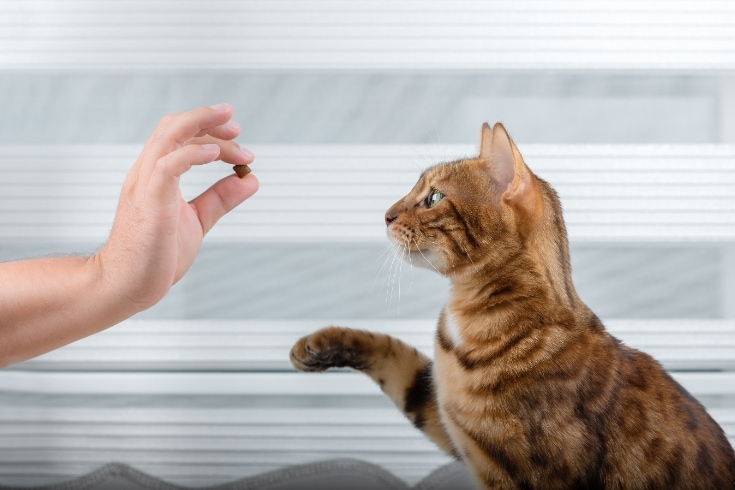
Positive reinforcement training is a reward-based training technique that uses a pleasant experience to reward your cat for exhibiting desired behaviors.
The cat receives a reward immediately after responding in the way the owner wants, so learns to associate that behavior with something good, making the animal more likely to repeat that behavior in the future.
Positive And Negative Reinforcement – What’s The Difference?
The difference between positive and negative reinforcement is defined as follows:
Positive Reinforcement
Negative Reinforcement
The cat receives a pleasant reward for a behavior, making it more likely the cat will repeat the behavior in the future.
Length: Something the cat likes is withheld to decrease the frequency of undesirable behavior.26cm
What Are The Benefits Of Positive Reinforcement?
The benefits of positive reinforcement training for cats include the following:
Improved Cat Behavior
Positive reinforcement training can help to improve your cat’s behavior since the cat learns that she will earn a reward if she behaves in a certain way.
For example, the cat learns that scratching the furniture gets her0 nothing, whereas using her scratching pole or mat gets her your praise, a head rub, and a tasty treat. So, as far as your cat is concerned, using the scratch pole instead of your favorite armchair is a no-brainer!
Strengthened Owner-Cat Relationship
In my experience, most cats respond best to praise, affection, and food rewards, depending on the kitty’s individual preferences and personality.
So, it follows that the more pleasant experiences you give your cat, the stronger and happier your relationship will be.
Increased Cat Confidence And Security
As your relationship with your pet improves, your cat will begin to feel more safe and secure in her home, and so she will become more confident.
Enhanced Mental Stimulation
Positive reinforcement training encourages your cat to think for herself and behave in certain ways to gain a reward. That can provide your feline friend with the physical and mental stimulation she needs to relieve stress and keep her feeling happy and relaxed.
What Are The Types Of Positive Reinforcement Techniques For Cats?
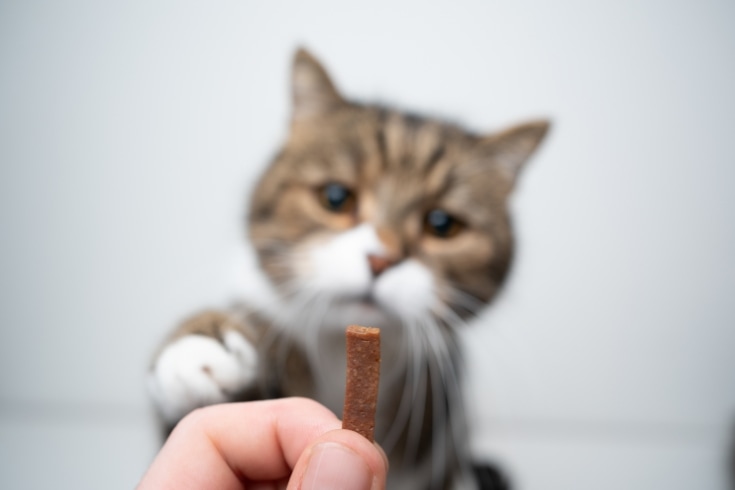
The types of positive reinforcement training for pets, including cats, can take various forms, as outlined below.
Food Rewards
Some cats respond well to food rewards, such as treats, and these are commonly used during positive reinforcement training.
Basically, you give your cat a treat as soon as she responds correctly to a command. That way, the cat learns that behaving that way will earn her a tasty reward, so she will be more likely to repeat the behavior.
Clicker Training
A clicker is a small, handheld device that makes a clicking sound when pressed. A clicker is generally used in conjunction with giving some kind of reward immediately after the cat exhibits a desired behavior.
Play And Interactive Toys
Not all cats are interested in food, and treat rewards can be inappropriate for overweight cats. Instead, you can use playtime to reward desired behavior.
Verbal Praise And Affection
Most cats respond well to verbal praise, cuddles, and petting, and you can use that as a reward when using positive reinforcement training.
Target Training
A target stick is a short stick with a ball fixed to one end. The stick is used to direct a cat’s attention toward something during training sessions, for example, to encourage the cat to move from one place to another.
Environmental Enrichment
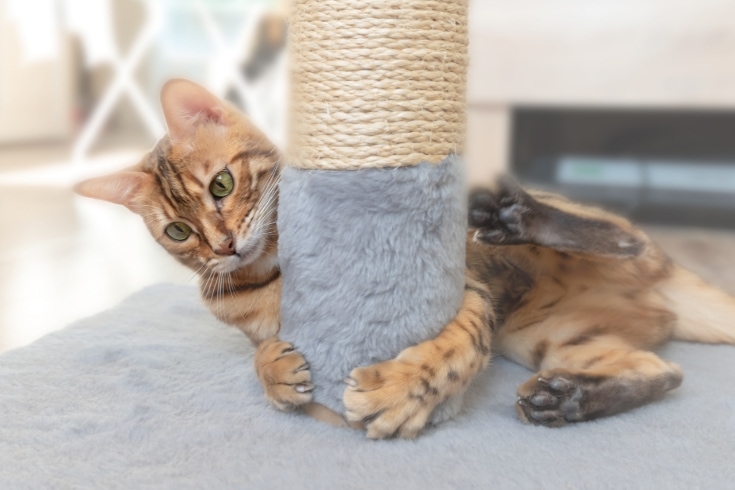
If you don’t want your cat to scratch your floor coverings or furniture, you might provide her with a scratching mat or scratching post, enriching her environment in a positive way rather than punishing her for inappropriate behavior.
What Items Are Necessary For Positive Reinforcement Training For Cats?
The items you need for positive reinforcement training are all readily available from your local pet store or online, and in some cases, you can take the DIY route to save cash!
Treats
If your cat is motivated by food, you’ll need a good supply of training treats to reward your pet when she does what you want.
One of my cats would do virtually anything for a particular brand of chicken-flavored soft treat, whereas the other isn’t particularly interested and would rather have a snuggle or a head rub as a reward for good behavior.
It’s really just a case of getting to understand your cat and what motivates her so that you can choose the most appropriate reward.
Toys
Toys can be a great motivator for cats, especially kittens, and a good selection of interactive toys can be an excellent way of rewarding your cat for good behavior and for teaching her tricks.
Clicker
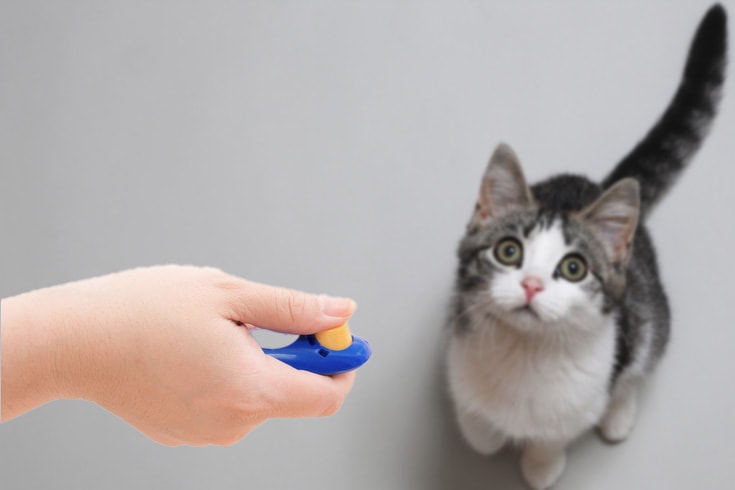
A clicker device is used to tell your cat that she’s responded correctly to one of your cue words or signals. Most people use a combination of a click and a reward of some kind to reinforce their cat’s good behavior.
Training Mat
A training mat is a device that’s commonly used during cat negative reinforcement training. Some mats are constructed from plastic “spikes” that the cat is reluctant to walk on, whereas others give out a mild pulse that the cat finds unpleasant.
Target Stick
A target stick is a short wand with a ball on one end that’s used to direct the cat or move her from one place to another.
Treat Pouch Or Container
A small treat pouch or container that’s used to carry your cat treats or food rewards, saving you the mess and hassle of rooting around in your pocket or treat packet for a reward.
Litter Box
One of the most important training elements for your cat is litter training, and a litter box is essential to teach your cat where to “go” in your home.
Fortunately, most cats are naturally clean animals that willingly use the litter box with very little training from you. Just be sure to use a type of litter that your cat recognizes and is comfortable with to prevent accidents.
Scratching Post
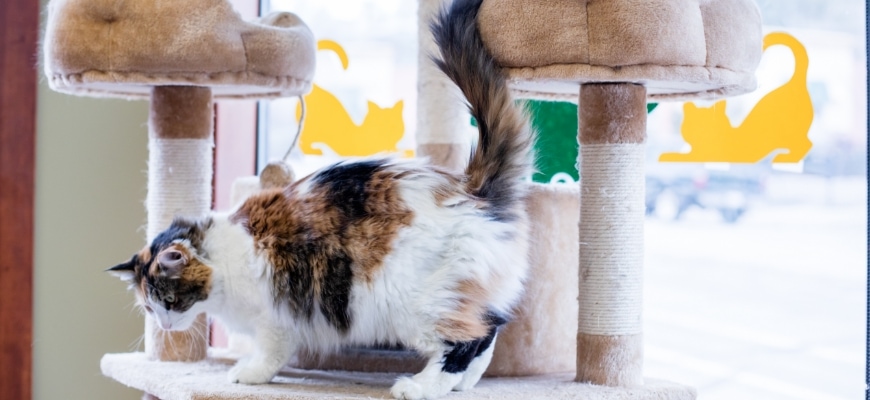
A scratching post is an upright, sisal-covered pole set on a stable base that your cat uses to sharpen her claws rather than doing so on your furniture or floor coverings.
A Quiet And Distraction-Free Environment
Cats are naturally curious creatures and noisy kids, a TV program or even street noise can be enough to ruin a training session, so when you want to train your cat, it’s essential to do so in a quiet and distraction-free environment.
How Do You Train A Cat Using Positive Reinforcement?
To train a cat using positive reinforcement, you’ll need to assemble all the things you’re going to need, choose a quiet, distraction-free space in your home, make sure your cat is fed, rested, and that she’s in the correct frame of mind for a training session.
Identify The Desired Behavior
Before you begin each training session, you must be clear on what you want to teach your cat. For example, you might want to train your cat to use her scratching post instead of your sofa or to sit on command.
Choose A Reward
Decide what most motivates your cat and choose a suitable reward. For example, if your cat would kill for a juicy treat, ensure your treat pouch is full before you begin!
Timing Is Key
Choosing the best time to train your cat using positive reinforcement is key to success. If your cat is hungry, tired, expecting to go outside, or in a feisty mood, you’re probably wasting your time trying to teach her anything!
So, pick a regular time every day when you know you’ll be free to work with your pet and she will be in the correct frame of mind to learn.
Use A Clicker (Optional)
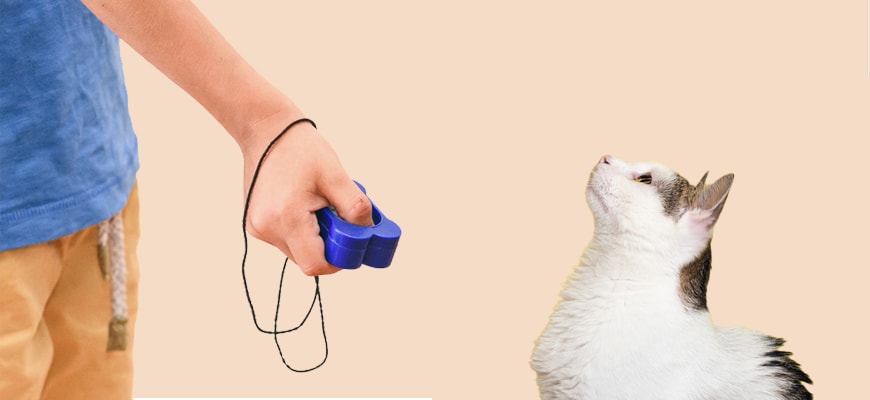
Many cat and dog owners find using a clicker device extremely helpful in training their pets, but that’s a matter of personal choice.
If you’ve never used a clicker before, practicing before you begin using it in training sessions is a good idea. Also, some cats don’t like the sound made by the clicker, whereas others simply ignore it, so you should also check that your pet is receptive to the device before you start.
Break It Down
Cats learn at different speeds, and some are quicker to catch on than others. So, make positive reinforcement training easier for your pet by breaking down each training session into small, bite-sized chunks, only moving on when you’re confident your cat fully understands what you want.
Be Patient And Consistent
An important part of positive reinforcement training is patience. Some cats pick up commands incredibly quickly, whereas others are slower to learn, so don’t try to rush your pet’s training.
It’s also essential to be consistent in your verbal and physical cues so that your cat doesn’t get confused, and if other members of your household are going to assist you in the training process, ensure they use the same cues as you.
Ignore Unwanted Behaviors
If your cat doesn’t respond in the way you want her to, simply ignore the unwanted behavior and repeat your training command, remembering to reward your pet the moment she does what you want.
That way, the cat learns that undesirable behaviors get her nothing, whereas if she responds correctly to what you ask of her, she will immediately receive a pleasant reward.
Repeat And Reinforce
Positive reinforcement training for cats effectively conditions the cat to expect a reward of some kind when she performs a correct behavior or responds in the right way to one of your commands. So, by repeating and reinforcing positive behavior, you’re building a firm foundation for your cat’s future behavior.
What Are Some Tips For Training A Cat Using Positive Reinforcement?
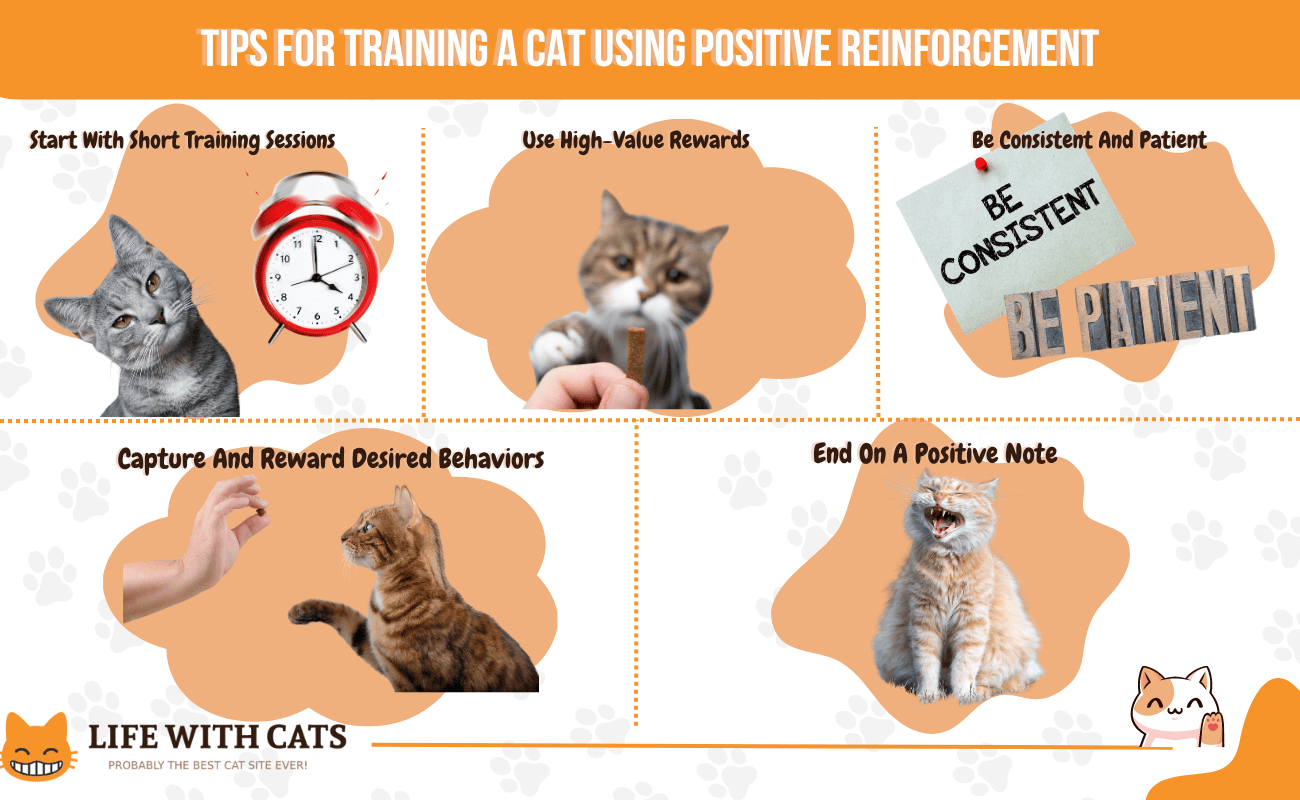
Here are some tips for training a cat using positive reinforcement techniques.
Start With Short Training Sessions
Don’t expect too much from your cat when you first begin her training sessions. Cats typically have a short attention span, and if the session goes on for too long, your pet will likely get bored and fail to make progress, even if there are lots of rewards on offer!
Ideally, your positive reinforcement training sessions should last for around 10 to 15 minutes, shorter for kittens and senior cats.
Use High-Value Rewards
Whether you opt to use food-based rewards, toys, or affection, the rewards you use must be something your cat craves and will do anything to get. That way, your pet will be keen to exhibit whatever behavior she needs to to get that high-value reward.
Be Consistent And Patient
Some cats learn quicker and easier than others, so be patient if your cat doesn’t catch on to what you want right away, and be prepared to take more time, using as much repetition as you need to.
Keep your verbal cues and physical gestures consistent so that your cat doesn’t get confused, and be sure to reward her immediately with a high-value treat when she exhibits the behavior you want.
Capture And Reward Desired Behaviors
If you see your cat performing a desired behavior, such as using her scratching post or litter tray, be sure to consolidate that behavior by immediately rewarding your pet. That way, your cat learns that whatever she’s doing is right and will earn her a reward.
End On A Positive Note
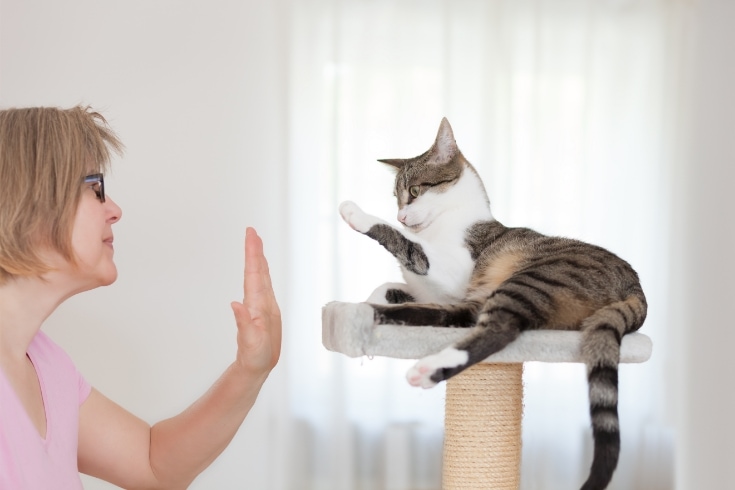
Every training session should end on a positive note.
So, if you find your cat is struggling to learn a new trick, don’t keep pressing ahead, as doing so only reinforces the failure and could demotivate and stress your pet. Instead, choose a command your cat has mastered, have her perform the desired behavior, and reward her. Make a fuss of your cat and end the day’s training session there.
What Are Some FAQ’s About Positive Reinforcement For Cats?
Here are the answers to some of the most frequently asked questions about using positive reinforcement training for cats.
What Is The Difference Between Positive Reinforcement And Negative Punishment?
Positive reinforcement training involves rewarding your cat with a treat of some kind when she exhibits a desired behavior. In contrast, negative punishment means that the cat doesn’t receive a reward, or something the cat wants is withheld.
Never physically punish or yell at your cat if she does something wrong or doesn’t behave as you want her to.
That will only make your cat afraid of you and will undoubtedly set your training back considerably.
How Long Does It Take To Train A Cat Using Positive Reinforcement?
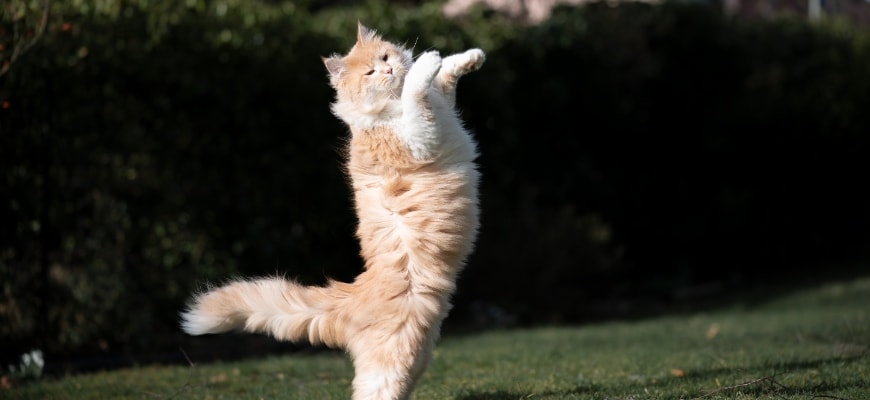
The length of time it takes to train your cat using positive reinforcement depends on your cat’s temperament, age, and background. The degree of difficulty of the command or trick you’re trying to teach your cat also heavily influences the length of time it takes to train her.
For example, my cats were litter trained as kittens within a day, but training them not to dig up my houseplants took a couple of weeks!
Can Positive Reinforcement Training Be Used For Cats Of All Ages?
Whether you want to teach your kitten to sit down on command or your elderly house cat to come when you call him, you can use positive reinforcement training for cats of any age!
How Do I Choose The Right Rewards For Positive Reinforcement Training With My Cat?
Every cat has a favorite thing. That could be a tasty food treat, her owner’s love and affection, or a game with a favorite toy.
So, you must first get to know your cat’s likes, dislikes, and motivation so that you can choose the right reward for positive reinforcement training with your cat.
Conclusion
Did you enjoy our guide to positive reinforcement training for cats? If you did, don’t forget to hit the share button before you go!
Positive reinforcement for cats is a reward-based training technique that you can use to teach your furry friend fun tricks and basic commands. The idea is that your cat learns to associate performing certain behaviors with receiving a high-value reward of some kind, making it more likely the cat will repeat the behaviors in the future.
You can use various tools for positive reinforcement training, including food rewards, toys and play, a clicker, verbal praise, petting, environmental enrichment, and target training.
What’s your cat’s favorite high-value treat? Tell us in the comments box below!